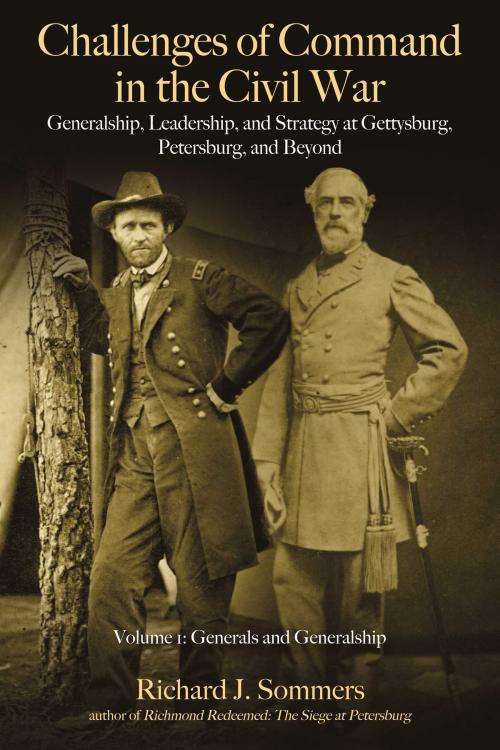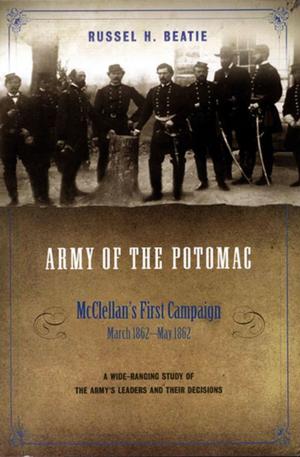Challenges of Command in the Civil War
Generalship, Leadership, and Strategy at Gettysburg, Petersburg, and Beyond, Volume I: Generals and Generalship
Nonfiction, History, Americas, United States, Civil War Period (1850-1877), Military| Author: | Richard J. Sommers | ISBN: | 9781611214338 |
| Publisher: | Savas Beatie | Publication: | June 14, 2018 |
| Imprint: | Savas Beatie | Language: | English |
| Author: | Richard J. Sommers |
| ISBN: | 9781611214338 |
| Publisher: | Savas Beatie |
| Publication: | June 14, 2018 |
| Imprint: | Savas Beatie |
| Language: | English |
Dr. Richard Sommers’ Challenges of Command in the Civil War distills six decades of studying the Civil War into two succinct, thought-provoking volumes. This first installment focuses on “Civil War Generals and Generalship.” The subsequent volume will explore “Civil War Strategy, Operations, and Organization.” Each chapter is a free-standing essay that can be appreciated in its own right without reading the entire book.
Ulysses S. Grant and Robert E. Lee stand out in Volume I as Dr. Sommers analyzes their generalship throughout the Civil War. Their exercise of command in the decisive Virginia Campaign from May 1864 to April 1865 receives particular attention—especially during the great Siege of Petersburg, about which the author has long ranked as the pioneering and pre-eminent historian.
Five chapters evaluating Grant and Lee are followed by five more on “Civil War Generals and Generalship.” One of those essays, “American Cincinnatus,” explores twenty citizen-soldiers who commanded mobile army corps in the Union Army and explains why such officers were selected for senior command. Antietam, Gettysburg, and Petersburg are central to three essays on Northern corps and wing commanders. Both Federals and Confederates are featured in “Founding Fathers: Renowned Revolutionary War Relatives of Significant Civil War Soldiers and Statesmen.” The ground-breaking original research underlying that chapter identifies scores of connections between the “Greatest Generations” of the 18th and 19th Centuries—far more than just the well-known link of “Light Horse Harry” Lee to his son, Robert E. Lee.
From original research in Chapter 10 to new ways of looking at familiar facts in Chapters 6-9 to distilled judgments from a lifetime of study in Chapters 1-5, Challenges of Command invites readers to think—and rethink—about the generalship of Grant, Lee, and senior commanders of the Civil War.
This book is an essential part of every Civil War library.
Dr. Richard Sommers’ Challenges of Command in the Civil War distills six decades of studying the Civil War into two succinct, thought-provoking volumes. This first installment focuses on “Civil War Generals and Generalship.” The subsequent volume will explore “Civil War Strategy, Operations, and Organization.” Each chapter is a free-standing essay that can be appreciated in its own right without reading the entire book.
Ulysses S. Grant and Robert E. Lee stand out in Volume I as Dr. Sommers analyzes their generalship throughout the Civil War. Their exercise of command in the decisive Virginia Campaign from May 1864 to April 1865 receives particular attention—especially during the great Siege of Petersburg, about which the author has long ranked as the pioneering and pre-eminent historian.
Five chapters evaluating Grant and Lee are followed by five more on “Civil War Generals and Generalship.” One of those essays, “American Cincinnatus,” explores twenty citizen-soldiers who commanded mobile army corps in the Union Army and explains why such officers were selected for senior command. Antietam, Gettysburg, and Petersburg are central to three essays on Northern corps and wing commanders. Both Federals and Confederates are featured in “Founding Fathers: Renowned Revolutionary War Relatives of Significant Civil War Soldiers and Statesmen.” The ground-breaking original research underlying that chapter identifies scores of connections between the “Greatest Generations” of the 18th and 19th Centuries—far more than just the well-known link of “Light Horse Harry” Lee to his son, Robert E. Lee.
From original research in Chapter 10 to new ways of looking at familiar facts in Chapters 6-9 to distilled judgments from a lifetime of study in Chapters 1-5, Challenges of Command invites readers to think—and rethink—about the generalship of Grant, Lee, and senior commanders of the Civil War.
This book is an essential part of every Civil War library.















